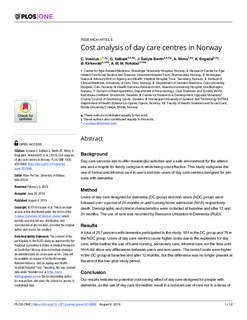| dc.contributor.author | Vossius, Corinna Elisabeth | |
| dc.contributor.author | Selbæk, Geir | |
| dc.contributor.author | Saltyte Benth, Jurate | |
| dc.contributor.author | Wimo, A. | |
| dc.contributor.author | Engedal, Knut | |
| dc.contributor.author | Kirkevold, Øyvind | |
| dc.contributor.author | Rokstad, Anne Marie Mork | |
| dc.date.accessioned | 2019-09-30T06:15:02Z | |
| dc.date.available | 2019-09-30T06:15:02Z | |
| dc.date.created | 2019-08-12T14:30:57Z | |
| dc.date.issued | 2019 | |
| dc.identifier.citation | PLOS ONE. 2019, 14 (8), . | nb_NO |
| dc.identifier.issn | 1932-6203 | |
| dc.identifier.uri | http://hdl.handle.net/11250/2619257 | |
| dc.description.abstract | Background: Day care services aim to offer meaningful activities and a safe environment for the attendees and a respite for family caregivers while being cost effective. This study compares the use of formal and informal care in users and non-users of day care centres designed for persons with dementia. Method: Users of day care designed for dementia (DC group) and non-users (NDC group) were followed over a period of 24 months or until nursing home admission (NHA) respectively death. Demographic and clinical characteristics were collected at baseline and after 12 and 24 months. The use of care was recorded by Resource Utilization in Dementia (RUD). Results: A total of 257 persons with dementia participated in the study, 181 in the DC group and 76 in the NDC group. Users of day care centres cause higher costs due to the expenses for day care, while neither the use of home nursing, secondary care, informal care nor the time until NHA did show any differences between users and non-users. The overall costs were higher in the DC group at baseline and after 12 months, but this difference was no longer present at the end of the two-year study period. Conclusion: Our results indicate no potential cost-saving effect of day care designed for people with dementia, as the use of day care did neither result in a reduced use of care nor in a delay of NHA. Future research should balance the non-monetary benefits of day care against its costs for a full cost-effectiveness analysis, most favourable in a RCT-design. | nb_NO |
| dc.language.iso | eng | nb_NO |
| dc.publisher | Public Library of Science (PLOS) | nb_NO |
| dc.relation.uri | https://journals.plos.org/plosone/article/file?id=10.1371/journal.pone.0219568&type=printable | |
| dc.rights | Navngivelse 4.0 Internasjonal | * |
| dc.rights.uri | http://creativecommons.org/licenses/by/4.0/deed.no | * |
| dc.title | Cost analysis of day care centres in Norway | nb_NO |
| dc.type | Journal article | nb_NO |
| dc.type | Peer reviewed | nb_NO |
| dc.description.version | publishedVersion | nb_NO |
| dc.source.volume | 14 | nb_NO |
| dc.source.journal | PLOS ONE | nb_NO |
| dc.source.issue | 8 | nb_NO |
| dc.identifier.doi | 10.1371/journal.pone.0219568 | |
| dc.identifier.cristin | 1715334 | |
| dc.relation.project | Norges forskningsråd: 222083 | nb_NO |
| dc.description.localcode | Copyright: © 2019 Vossius et al. This is an open access article distributed under the terms of the Creative Commons Attribution License, which permits unrestricted use, distribution, and reproduction in any medium, provided the original author and source are credited. | nb_NO |
| cristin.unitcode | 194,65,70,0 | |
| cristin.unitname | Institutt for helsevitenskap Gjøvik | |
| cristin.ispublished | true | |
| cristin.fulltext | original | |
| cristin.qualitycode | 1 | |

